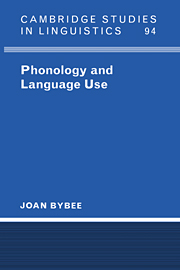Book contents
- Frontmatter
- Contents
- List of Figures
- List of Tables
- Acknowledgments
- 1 Language Use as Part of Linguistic Theory
- 2 A Usage-Based Model for Phonology and Morphology
- 3 The Nature of Lexical Representation
- 4 Phonological Processes, Phonological Patterns
- 5 The Interaction of Phonology with Morphology
- 6 The Units of Storage and Access: Morphemes, Words, and Phrases
- 7 Constructions as Processing Units: The Rise and Fall of French Liaison
- 8 Universals, Synchrony and Diachrony
- References
- Author Index
- Subject Index
- Languages Index
5 - The Interaction of Phonology with Morphology
Published online by Cambridge University Press: 03 December 2009
- Frontmatter
- Contents
- List of Figures
- List of Tables
- Acknowledgments
- 1 Language Use as Part of Linguistic Theory
- 2 A Usage-Based Model for Phonology and Morphology
- 3 The Nature of Lexical Representation
- 4 Phonological Processes, Phonological Patterns
- 5 The Interaction of Phonology with Morphology
- 6 The Units of Storage and Access: Morphemes, Words, and Phrases
- 7 Constructions as Processing Units: The Rise and Fall of French Liaison
- 8 Universals, Synchrony and Diachrony
- References
- Author Index
- Subject Index
- Languages Index
Summary
Introduction
A major focus of generative phonology has been on word-internal alternations – that is, cases in which a morpheme has phonological variants depending upon the word in which it appears (e.g., divine, divinity; keep, kept). Most of these alternations are morphologically and lexically conditioned, but the role of morphology and the lexicon has not been assessed directly in generative theory, as the assumption was made early on that the form and motivation for alternations involving the morphology and lexicon followed the same principles as those that were strictly phonological in nature. In fact, up to the present, generative frameworks (including Lexical Phonology) have paid very little attention to the nature of the morphological categories and lexical classes that govern morphophonological alternations. One goal of this chapter is to present evidence that the principles governing phonological patterns that reference morphology and lexicon are radically different in nature from those governing purely phonetically conditioned processes. The other goal is to review what is known about these lexical and morphological principles from the experimental, child language, and language change evidence.
The morphologization of phonological rules was discussed in Chapter 3.6, where it was argued that the involvement of phonological alternations with morphology occurs very early in the development of a phonological process, even while phonetic conditioning for the process is still present in the language. I also argued that there is an inexorable unidirectionality to the increasing morphological and lexical involvement in phonological alternations.
- Type
- Chapter
- Information
- Phonology and Language Use , pp. 96 - 136Publisher: Cambridge University PressPrint publication year: 2001
- 1
- Cited by



